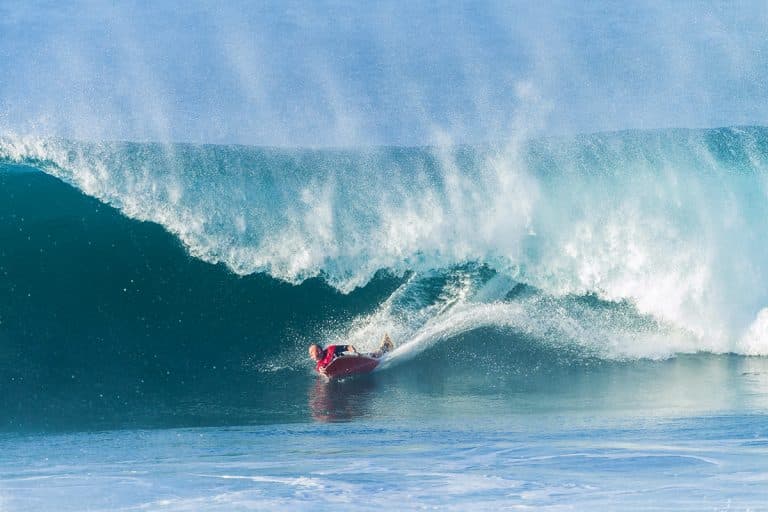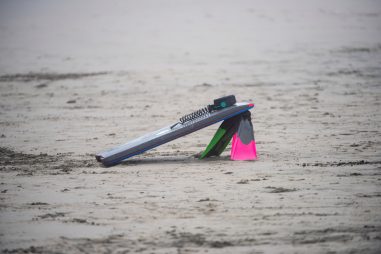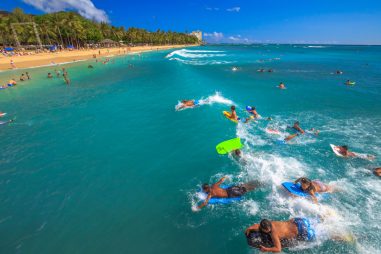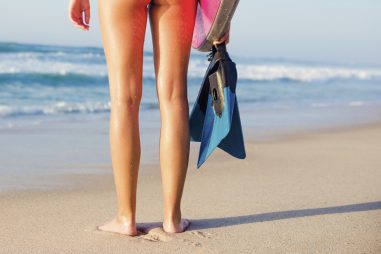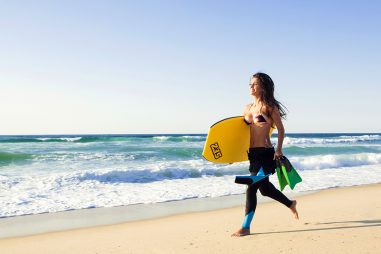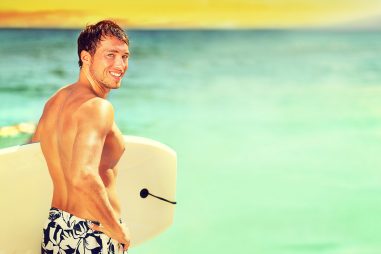First, the waves must be of sufficient height and at suitable intervals for bodyboarding. Too small waves or no waves at all would not be surfable. If the intervals between the waves are too short, then it will not be an ideal time to get on your board as it will get choppy out there. Second, the tide must be compatible with the beach you’re surfing on. It can either be high tide or low tide as long as it produces the waves you prefer. The third is the weather. Of course, a nice sunny weather with minimal wind would be perfect. Since we can’t control the weather, we’ll take whatever it gives us as long as we can go enjoy our bodyboarding time.
What Are the Best Waves for Bodyboarding?
You will, of course, want the best waves when you go bodyboarding. You may not always get the ideal wave, but any wave may still be able to provide you with a good time. It’s best to check the weather or surf report before heading out, so you know what kind of waves to expect. Here are a few things to watch for in the surf report if you’re going bodyboarding.
- The height: Small waves may not give you enough of a ride when bodyboarding. The bigger the wave, the more enjoyment you get out of the ride, if that is what you prefer. It would help if you rode the biggest wave you could comfortably ride. Riding a big wave that you cannot handle would cause you to wipe out again and again. And there’s no fun in that. Having said that, the only way to improve your bodyboarding skill is to push yourself and go big. So go ahead and push your limits. Safely, I might add.
- The wave interval: A shorter time interval between the waves will give you a choppy ride. A weather report with the phrase “8 feet at 15 seconds” means 8-foot waves at 15-second intervals. This is a very strong hint for you to go pack your gear and head out to the beach right away if you are up to it.
- The wind direction: The wind will dictate how big or how small the waves will be. If the wind is blowing offshore, you can expect better waves than if it is blowing onshore. The wind may also blow at an angle relative to the beach so this may give a different feel to the waves.
- The tide: Some bodyboarders prefer to go down to the beach when the tide is going up. Doing so gives them more time to enjoy doing their stuff since they spend less time paddling out and more time just riding their board. However, this also depends on the structure of the beach. Some beaches have better waves during low tide rather than during high tide. So, learn the features of the beach you will be surfing on.
What Height Waves Are Good for Bodyboarding?
Generally, the bigger the wave the better for bodyboarding. The ideal waves for you will depend on your skill level. Waves that are too small might not be challenging enough for you, while waves that are way too big may overwhelm you and cause you to wipe out many times. Either way, you will not get to enjoy the experience fully. Unless, of course, you are there to enjoy wiping out.
Smaller waves will be perfect if you are a beginner. You get a feel of how your board rides, how to maneuver your board, and just practice on your board. As you get more proficient at it, you can start going for a ride on bigger and bigger waves that you can handle. The best wave height for you would be something that would challenge you without putting you in danger.
Can You Bodyboard Small Waves?
As the surfing and bodyboarding great Mike Stewart once said, “You learn more from surfing small waves than you do from riding big waves.” Of course, you can bodyboard small waves. After all, this is where everyone first started when learning to Bodyboard. These are the waves where everyone learned their bodyboarding basics.
Avid bodyboarders can ride all types of waves. Having smaller than ideal waves gives you the opportunity to practice on some small details you might want to improve. Small waves are actually harder to ride, so you have to regularly make some adjustments to keep the board coasting through the water. Appreciating the smaller waves will remind you of why you got hooked on bodyboarding in the first place.
Can You Bodyboard in 1ft Waves?
If Tyrion was a bodyboarder and the Blackwater Bay had 1-foot waves, that would be perfect for him. Kidding aside, 1-foot-high waves would also be sufficient for normal-sized beginners learning to Bodyboard. Even for those who are already into the sport, 1-foot waves would be enough of an excuse to spend a day in the water.
Of course, you might not get the same rush when bodyboarding bigger waves, but this would be good enough for hard-core bodyboarders. One-foot waves would make for a lovely time just lazing around in the water when you are not in the mood for some strenuous activity but still want to get some rides in.
What Tide Is Best for Bodyboarding?
This is a question for which there is no one right or wrong answer. A lot of factors come into play, such as what type of beach do you have. Is it sandy or rocky? Are reefs or sandbars present? Each beach has a different structure and will therefore have different tides and wave formations depending on the time of day. Some beaches may have the best bodyboarding conditions during high tide, while some places may be better at low tide, so you have to know your surfing areas.
Don’t forget to utilize one of the most important resources when bodyboarding an unfamiliar beach. The local surfers can give you invaluable advice on when is the best time to Bodyboard that particular beach, whether low tide, high tide, or anytime in between. Focus instead on when waves are present rather than when it’s low tide or high tide.
Is High Tide or Low Tide Better for Bodyboarding?
The best tides for bodyboarding will depend on the beach structure without taking into account the weather. Some beaches may produce better waves during high tide, while others may have better bodyboarding conditions during low tide. There is no one size fits all answer to this question.
The main issue here is not the tidal cycle but whether surfable waves are present. Depending on your skill level and preference, you may prefer to Bodyboard when there are huge and challenging waves. Or you may opt for a more leisurely experience when the waves are gentler.
When is the Best Time to Go Bodyboarding?
This is It takes a bit of luck and a lot of planning to be in the right place at the right time to catch the best waves. You can chase the waves around the world if you are up to it (and when finances allow, of course). Below is a guide of the best times to visit some of the best bodyboarding areas around the world.
There may be some places not included in the list below that may suit your preferences. During those months, the weather may play a factor in the waves produced, so a disclaimer is in order. Waves are not guaranteed, but you will still have a blast in those places. Here goes the list in no particular order or wave quality.
- The Philippines: The best bodyboarding and surfing months are from December to May. The Philippines offers year-round surfing conditions but those months offer the most varied conditions starting from beginner up to the most challenging level.
- Indonesia: After the peak season from the Philippines, you may go on to Indonesia, which has its season from May to October. Indonesia also has year-round bodyboarding weather, but we’re talking of best times here, so May to October it is.
- Thailand: Thailand is also a great bodyboarding and surfing country from April to November. There’s something for everybody here, from beginners to advanced bodyboarders.
- Australia: Australia’s season runs from March to May, although it continues until September for hard-core surf riders.
- Fiji: The best time to Bodyboard in Fiji would be between April and October, although you can expect good waves throughout the year.
- Hawaii: The season is between November and March, which is when the larger waves get going. However, quality waves can also be seen between March and May.
- France: In parts of Europe, the huge and powerful swells ideal for advanced bodyboarders and surfers come in the winter months. Between December and February, the French coastline is struck by these large waves. The months between June to October are ideal for their warmer weather and moderate swells. Perfect for beginners and intermediate surfers.
- The United Kingdom: The perfect season for newbies and recreational bodyboarders and surfers in the UK starts in September and ends in November. The fun begins in December through March for the hard-core bodyboarders due to the bigger swells in those months.
- Portugal: Portugal’s season for beginners and intermediates is from May to September. As in other parts of Europe, the waves for the thrill-seekers come in October to April. Wetsuits are essential wear as the water gets really cold at this time.
- Spain: From June to August, Spain’s beaches are perfect for beginners and intermediates for its gentle waves. Between September and April, the cold weather brings with it the powerful swells and huge waves. An influx of bodyboarding and surfing enthusiasts can be expected to arrive for this event.
- Morocco: The high season is between September and April. The prime time is between December and March when powerful, heavy waves hit the coast, suitable for more experienced surfers.
- South Africa: In South Africa, the months of April and May are the most agreeable for bodyboarding and surfing. The season there runs from February to November.
- California: The winter months of December to February are the best months for bodyboarding and surfing in California. The Golden State is another year-round surfing spot that provides good waves for all types of surfers.
- South America: The South Americas have great locations as well. The best months to go bodyboarding in Mexico are from June to September. You can go bodyboarding throughout the year there, but these are the ideal months if you are an advanced surfer.
- Brazil: Brazil is another year-round destination. You can go to the northern part of Brazil between November and March and to the southern part between April and September.
- Chile: You can go any time of the year to Chile and be able to bodyboard. It’s another place where you can count on year-round bodyboarding and surfing.
- Costa Rica: This place is another year-round destination; the prime time to go bodyboarding and surfing in Costa Rica is between May-October and November-March.
- Peru: Northern Peru has swells throughout the year. The surf season in Southern Peru is between April and October.
- Nicaragua: This country is also a year-round surfing destination. The best time to go surfing in Nicaragua is from May to November.
When is the Best Time of the Day to Bodyboard?
Without putting a finer point to it, the best time to go bodyboarding is when the waves are up. This could be at any time during the day. Weather-wise, the best time to go bodyboarding would be during the early morning hours and the cooler hours in the afternoon. Generally speaking, the offshore winds blow early in the morning or late in the afternoon. The heat during the midday tends to suck in the wind from the ocean towards the land and helps to create more choppy waves.
However, different beaches will present differing situations. It’s important to do some research or scouting first if you are not familiar with the beach you will be surfing on. Locals will be able to give you pointers on when are the best times for their beach, so make sure to tap into this knowledge.
What Is the Best Weather for Bodyboarding?
The best time to Bodyboard is obviously a nice fine sunny day with your friends. However, it would be best if you did not let the weather dictate when you can bodyboard. Bodyboarding only when the weather is bright and sunny limits your experiences and the time when you can enjoy this sport to only when the weather is fair.
That might be okay to the weekend warriors, but a forecast of nasty weather is the same as a challenge to the hard-core bodyboarder. If you are planning to compete, then you have to learn to ride in different weather conditions. Who knows what type of weather conditions you’ll have when in competition? Learn to Bodyboard even in not-so-ideal conditions, and you might even find it enjoyable. Try bodyboarding on other beaches aside from the ones you’re familiar with. Doing so will help you learn how to handle different waves and improve your skills which might come in handy during competitions.

